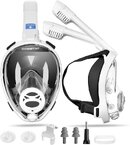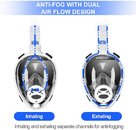Even if you could ventilate through a 3 feet long snorkel, and you cannot, all you would be doing is breathing the same increasingly CO2 rich air over and over.Ultimately, WOB is about CO2 buildup, not the differential pressure itself.
Yes, it does feel easy to pull a relative vacuum through a tube with your lungs in the 6-12" range. The difference is "feeling easy" when that vacuum is acting on small area is understandably misleading when apply it to WOB.
Sucking or blowing against a differential pressure that is perceived as insignificant can quickly cause a buildup of CO2, which causes that "air starved" sensation. A case in point are the absurdly long snorkels sold as pool toys in the 1950s.
Applied to scuba regulators, and I multiple times have worked in a scuba store, customers are always impressed with or concerned with ease of inhalation, specifically the percieved cracking effort. I never had anyone say, wow, this regulator exhales really easy or this regulator has a really strong Venturi effect. But those two things are more important than the cracking effort alone for the overall WOB.
Those ginormous ping pong ball snorkels would give me a headache, so would those twin snorkel full masks. But who cared, they were coo! I would suggest not taking a coil of hose fitted with a valve to the bottom of a pool and then sticking it on or in your mouth and then opening the valve to the hose. One end is at atmospheric pressure and now you are on the other end at more than atmospheric pressure. This is not good. Well, if it is a cheap hose it will just have collapsed. Better get a kink proof.
James






